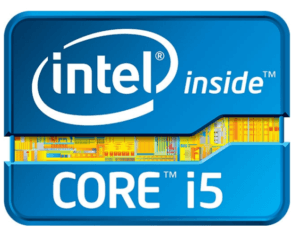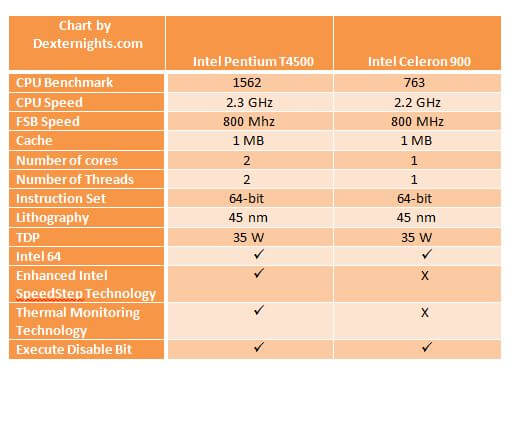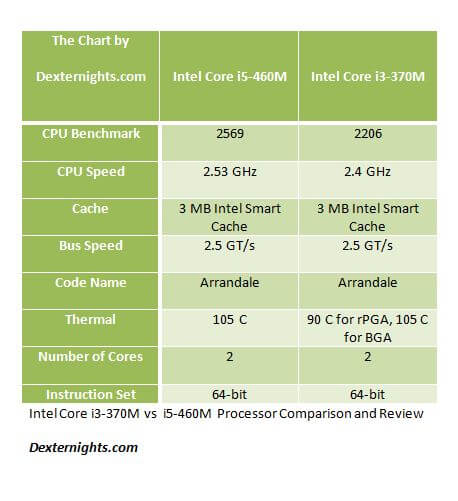Intel Core i5 Processors are considered to be workhorse processors falling between basic Intel Core i3 and Powerhouse Intel Core i7 processors.
Price of Intel Core i5 processors have been low enough to be very competitive with Intel Core i3 processors. We are comparing three i5 processors using the same 14nm process.
Primary difference between each of these processors is CPU clock speed, from 5200 to 6200 and then to 7200 there is a gradual improvement in clocks speed. Difference between i5-5200 and i5-6200 is only 4% where i5-7200 shows a 10% increase over i5-6200. But still if there is a $100 difference with the older model, it is wise to take the lower price.
In terms of Memory i5-5200U can only support 16GB RAM. i5-6200U and i5-7200U can support upto to 32 GB. 6th and 7th generation i5 processors support DDR4 while Gen 5 doesnt support DDR4. But most laptops come with less than 16GB RAM.
Other big change is support for 4K resolutions in i5-6200U and i5-7200U.
There is better thermal performance with the newer processors but not as significant.
Please have a look at the below details for more information. Overall there is not much to choose between these Mid Tier i5 cpus. But if you are looking for 4K resolution or DDR4 , then you now know which ones to pick.
|
Product Name
|
Intel Core i5-5200U Processor (3M Cache, up to 2.70 GHz) | Intel Core i5-6200U Processor (3M Cache, up to 2.80 GHz) | Intel Core i5-7200U Processor (3M Cache, up to 3.10 GHz) |
|
Code Name
|
Broadwell | Skylake | Kaby Lake |
|
–
Essentials |
|||
|
Processor Number
|
i5-5200U | i5-6200U | i5-7200U |
|
Launch Date
|
Q1’15 | Q3’15 | Q3’16 |
|
Lithography
|
14 nm | 14 nm | 14 nm |
|
–
Performance |
|||
|
# of Cores
|
2 | 2 | 2 |
|
# of Threads
|
4 | 4 | 4 |
|
Processor Base Frequency
|
2.20 GHz | 2.30 GHz | 2.50 GHz |
|
Max Turbo Frequency
|
2.70 GHz | 2.80 GHz | 3.10 GHz |
|
Cache
|
3 MB | 3 MB SmartCache | 3 MB SmartCache |
|
Bus Speed
|
5 GT/s DMI2 | 4 GT/s OPI | 4 GT/s OPI |
|
TDP
|
15 W | 15 W | 15 W |
|
Configurable TDP-down Frequency
|
600.00 MHz | 800.00 MHz | 800.00 MHz |
|
Configurable TDP-down
|
7.5 W | 7.5 W | 7.5 W |
|
Configurable TDP-up Frequency
|
2.40 GHz | 2.70 GHz | |
|
Configurable TDP-up
|
25 W | 25 W | |
|
–
Supplemental Information |
|||
|
Embedded Options Available
|
No | No | No |
|
Datasheet
|
Link | Link | Link |
|
Conflict Free
|
Yes | Yes | Yes |
|
|
|||
|
–
Memory Specifications |
|||
|
Max Memory Size (dependent on memory type)
|
16 GB | 32 GB | 32 GB |
|
Memory Types
|
DDR3L 1333/1600, LPDDR3 1333/1600 | DDR4-2133, LPDDR3-1866, DDR3L-1600 | DDR4-2133, LPDDR3-1866, DDR3L-1600 |
|
Max # of Memory Channels
|
2 | 2 | 2 |
|
Max Memory Bandwidth
|
25.6 GB/s | 34.1 GB/s | 34.1 GB/s |
|
ECC Memory Supported ‡
|
No | No | |
|
–
Graphics Specifications |
|||
|
Processor Graphics ‡
|
Intel® HD Graphics 5500 | Intel® HD Graphics 520 | Intel® HD Graphics 620 |
|
Graphics Base Frequency
|
300.00 MHz | 300.00 MHz | 300.00 MHz |
|
Graphics Max Dynamic Frequency
|
900.00 MHz | 1.00 GHz | 1.00 GHz |
|
Graphics Video Max Memory
|
16 GB | 32 GB | 32 GB |
|
Graphics Output
|
eDP/DP/HDMI | eDP/DP/HDMI/DVI | eDP/DP/HDMI/DVI |
|
Max Resolution (HDMI 1.4)‡
|
2560X1600@60Hz | 4096×2304@24Hz | 4096×2304@24Hz |
|
Max Resolution (DP)‡
|
3840×2160@60Hz | 4096×2304@60Hz | 4096×2304@60Hz |
|
DirectX* Support
|
11.2/12 | 12 | 12 |
|
OpenGL* Support
|
4.3 | 4.4 | 4.4 |
|
Intel® Quick Sync Video
|
Yes | Yes | Yes |
|
Intel® InTru™ 3D Technology
|
Yes | Yes | Yes |
|
Intel® Flexible Display Interface (Intel® FDI)
|
Yes | ||
|
Intel® Clear Video HD Technology
|
Yes | Yes | Yes |
|
Intel® Clear Video Technology
|
Yes | Yes | Yes |
|
Intel® Wireless Display
|
Yes | Yes | |
|
# of Displays Supported ‡
|
3 | 3 | 3 |
|
Device ID
|
0x1616 | 0x1916 | 0x5916 |
|
4K Support
|
Yes, at 60Hz | Yes, at 60Hz | |
|
Max Resolution (Intel® WiDi)‡
|
1080p | ||
|
Max Resolution (eDP – Integrated Flat Panel)‡
|
4096×2304@60Hz | 4096×2304@60Hz | |
|
Max Resolution (VGA)‡
|
N/A | N/A | |
|
–
Expansion Options |
|||
|
PCI Express Revision
|
2.0 | 3.0 | 3.0 |
|
PCI Express Configurations ‡
|
4×1, 2×4 | 1×4, 2×2, 1×2+2×1 and 4×1 | 1×4, 2×2, 1×2+2×1 and 4×1 |
|
Max # of PCI Express Lanes
|
12 | 12 | 12 |
|
–
Package Specifications |
|||
|
Sockets Supported
|
FCBGA1168 | FCBGA1356 | FCBGA1356 |
|
Max CPU Configuration
|
1 | 1 | 1 |
|
TJUNCTION
|
105°C | 100°C | 100°C |
|
Package Size
|
40mm x 24mm x 1.3mm | 42mm X 24mm | 42mm X 24mm |
|
Low Halogen Options Available
|
See MDDS | See MDDS | See MDDS |
|
–
Advanced Technologies |
|||
|
Intel® Turbo Boost Technology‡
|
2.0 | 2.0 | 2.0 |
|
Intel® Hyper-Threading Technology ‡
|
Yes | Yes | Yes |
|
Intel® Virtualization Technology (VT-x) ‡
|
Yes | Yes | Yes |
|
Intel® Virtualization Technology for Directed I/O (VT-d)‡
|
Yes | Yes | Yes |
|
Intel® VT-x with Extended Page Tables (EPT) ‡
|
Yes | Yes | Yes |
|
Intel® 64 ‡
|
Yes | Yes | Yes |
|
Instruction Set
|
64-bit | 64-bit | 64-bit |
|
Instruction Set Extensions
|
SSE4.1/4.2, AVX 2.0 | SSE4.1/4.2, AVX 2.0 | SSE4.1/4.2, AVX 2.0 |
|
Idle States
|
Yes | Yes | Yes |
|
Enhanced Intel SpeedStep® Technology
|
Yes | Yes | Yes |
|
Thermal Monitoring Technologies
|
Yes | Yes | Yes |
|
Intel® Fast Memory Access
|
Yes | ||
|
Intel® Flex Memory Access
|
Yes | Yes | Yes |
|
Intel® Identity Protection Technology ‡
|
Yes | Yes | |
|
Intel® Small Business Advantage
|
Yes | Yes | |
|
Intel® Smart Response Technology
|
Yes | Yes | Yes |
|
Intel® vPro Technology ‡
|
No | No | |
|
Intel® TSX-NI
|
No | No | |
|
Intel® Stable Image Platform Program (SIPP)
|
No | No | |
|
Intel® My WiFi Technology
|
Yes | Yes | |
|
Intel® Speed Shift Technology
|
Yes | ||
|
–
Intel® Data Protection Technology |
|||
|
Intel® AES New Instructions
|
Yes | Yes | Yes |
|
Secure Key
|
Yes | Yes | Yes |
|
Intel® Software Guard Extensions (Intel® SGX)
|
Yes | Yes | |
|
Intel® Memory Protection Extensions (Intel® MPX)
|
Yes | Yes | |
|
–
Intel® Platform Protection Technology |
|||
|
Execute Disable Bit ‡
|
Yes | Yes | Yes |
|
OS Guard
|
Yes | Yes | Yes |
|
Trusted Execution Technology‡
|
No | No | |


